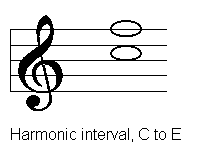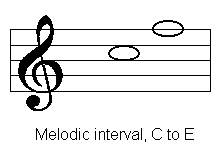
The distance between the pitches of two notes is known as an interval, and is measured in semitones. On the guitar, 1 fret = 1 semitone (or half-step), 2 frets = 1 whole tone (or whole-step). Note that this tutorial just deals with intervals of less than 1 octave (12 semitones); there'll be another tutorial at a later date which covers bigger intervals.
When referring to intervals, the interval can be given a name based upon the distance between the notes within a scale. For example, using the C major scale:
Naming Convention:
An interval can be 'harmonic' or 'melodic' - when two notes are played together then the interval between them is said to be harmonic; a melodic interval occurs between two notes played in succession:
 |
 |
Each interval, whether harmonic or melodic, has its own unique sound. Some intervals, such as a perfect fifth, or octave have a fairly consonant (or resolved) sound. Others, such as a minor 2nd or diminished 5th have a much more dissonant (or unresolved) sound. The degree of consonance/dissonance is particular to the size of the interval, and not to its notes. For example, perfect 5th between C and G sounds just as resolved as an interval of a perfect fifth between A and E.
Training you ear to recognise the sound of each interval is a vital skill. Spend time learning the names of intervals, and understand how they relate to the parent major scale. More importantly, put the theory into practise: as part of your daily practise routine, spend time playing and listening to intervals - in time you will come to recognise them upon first hearing. It will seem like hard work at first, but it is a very worthwhile investment of your time so persevere.
Guitarists might also find it useful to refer to this chart to see how intervals are laid out on the fingervboard.
More about ear-training in a later tutorial, but in the meantime...good luck.
How useful did you find this tutorial?
| Product/Info... | PhatPhish Application | | | Product Help | | | GUPPY - PhatPhish for the web | | | About The Author |
|---|
| Get Stuff... | Download PhatPhish | | | Mechandise | | | Blank Stave And Tab Sheets | | | Tutorials |
|---|
| Do Stuff... | Register | | | Feedback | | | Links | | | Donate | | | Ask A Question |
|---|
| Social Media... | YouTube | | | | |
|---|
| Promote... | Spread The Word | | | Posters/Flyers |
|---|
| Play... | PhatPhish Picks - Boutique Plectrums |
|---|
| ©2002-2022, Dave Dixon / CyberFlotsam http://www.cyberflotsam.com |